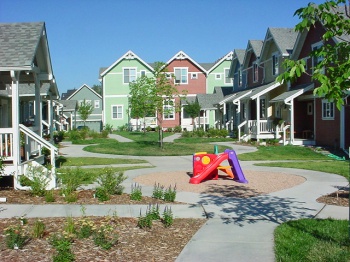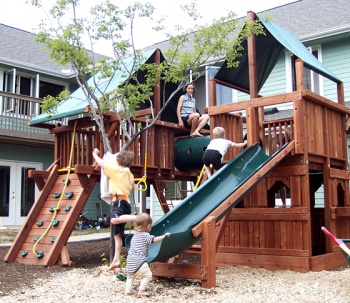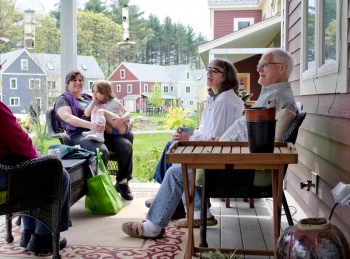 Cohousing by PLACEMATTERS
Cohousing by PLACEMATTERS
Fed up with impersonal apartments in the city? Do you sometimes wish to meet your neighbours, or at least know their names? Maybe cohousing could be the answer for you. Cohousing is a contraction of "collaborative housing" and it signifies neighbourhoods that try to combine the advantages of autonomous private dwellings and shared facilities supporting the life of the community. These intentional communities are often compared to the ideal of the small-town communities our grandparents used to live in — everybody knows each other and is ready to give a helping hand in need. While some see the concept as a return to the past, others believe that cohousing is the ultimate solution for 21st century living, considering the social, economic, and environmental advantages it entails.
History
The modern-day cohousing idea comes from Denmark, as the 1960s spirit caused dissatisfaction for many people with their way of living in shut-off houses and apartments with no interaction with the other residents in the area. The first communities figured out what they really wanted: living together in a new way that respects one’s privacy yet encourages a sense of belonging to an active community that does its best to contribute to a more sustainable and colourful world. Even though some people found the theory too utopian or saw links to the kibbutz system in Israel that has a strong socialist connotation and pursues the extends the meaning of common ownership as far as possible, cohousing survived the ’60s craze and proved itself to be a valuable alternative to “normal” dwellings. (In Denmark, about 10 per cent of all new construction is inspired by the model.) The first cohousing communities in North America sprang up in 1991, and more than 127 of them have been completed since then, while about 118 are in development at the moment. It is difficult to estimate the precise number of cohousing communities in Canada since new ones are being planned and constructed virtually every day.
What Is Cohousing?

Cohousing playground by Wikimedia
Commons
In most cohousing communities, residents own their houses that are completely self-sufficient. (Every reasonable urban planner respects the fact that people don’t feel like socializing all the time.) However, an important feature of cohousing communities is a special emphasis on shared facilities. Individual homes are usually clustered around so-called common houses that shelter most of the shared amenities. There are different designs, but this mostly includes a huge common kitchen and dining room, an arts and crafts area, workshops, a children’s playroom, laundry, guest rooms, and many more, depending on the decision of the community. Residents often organize common activities and interact on an everyday basis. Typical examples could be the preparation of common dinners, or even designated voluntary cooking teams serving meals for anyone interested, the building of children’s playground together, and organizing parties or festivals — basically anything community thinks of.
Ronaye Matthew, a consultant for cohousing developments and a member of a little cohousing community on Albert Street in Burnaby, comments on the advantages of shared facilities: “What that does is it allows us to have smaller homes, which contributes to affordability, but it also allows us to be more environmentally responsible. So things like a workshop and guest rooms and meeting spaces we can share together, rather than having to have it in our single-family homes.” Community life also has another important advantage: by knowing your neighbours, less money is wasted on babysitters, plumbers, or gardeners, as many little things are solved in a collaborative way, reducing the need for outside support. Communities also show much lower crime rates, as all the neighbours know each other. Cohousing dwellings provide much more safety and security than normal housing areas.
The size of the communities varies, but 10 to 35 households is an ideal number of dwellers that can keep close relationships without too much danger of getting on each other’s nerves in a small group. Typically, the cohousing concept tries to create a varied and well balanced environment by emphasizing the mix of generations and genders and singles, couples, and families with children. Furthermore, most communities aim to be as ecological as possible and move cars to the periphery, while pursuing a pedestrian-oriented core. However, it’s important to note that regardless of any theory, it’s the members of the community itself that do the planning. Future residents always participate in the design and development of the community so that it suits their wishes and needs. If any kind of nice and well-planned housing community springs up without consulting its future residents, it’s not a proper cohousing neighbourhood anymore. The democratic decision-making process must be at the very core of the community spirit and accompany its whole existence, and while there must be leadership roles present, no leaders operate within groups and a single person shouldn’t possess more power than others.
 Cohousing by Tim Pierce
Cohousing by Tim Pierce
Residents of the community don’t have a shared economy; they only invest in the improvement of the community once they agree to it. In Canada, cohousing units are usually owned through strata titles. However, as already mentioned, building a cohousing community shouldn’t follow conventional condo developments, since the future residents have their say in the planning process. After construction, individual houses are bought and can be sold later; there are no additional “community” strings attached that could halt anyone’s ownership rights. Cohousing neighbourhoods are not housing cooperatives. Co-op members own the housing units and have to purchase shares as well, giving them the right to occupy the unit. While this seems like a smart idea, it’s not very common, since it’s very difficult to get a mortgage for this type of ownership structure.
Cohousing Challenges
What are the biggest challenges that people interested in developing a cohousing community have to face? The most difficult part is certainly finding and purchasing enough parcels of land for the project. “There had been many groups in Vancouver who had formed and tried to find land and have fallen apart because they’ve gotten frustrated and haven’t been able to get land,” Matthew said. People interested in creating a cohousing community are not developer companies, which have resources and means to get the money at the moment when opportunity arises and quite a big piece of land is needed to support tens of new households. Matthew continues: “Typically, you can’t just buy one single-family house and build a cohousing community in it because there isn’t enough land in it. You very often need to do a land assembly, where you buy several properties together.”
Maybe the possible solution for these problems could be the support of municipal governments. Firstly, they can encourage cohousing practices by awarding the interested parties with a priority whenever any city land is up for sale, and secondly, local governments can give a helping hand by supporting the communities during the rezoning process. For example, sometimes single-family lots with mansions are up for sale and it’s up to the city to allow the denser construction of smaller dwellings. So far, nobody has been calling for direct government subsidies for cohousing developments, but maybe it’s time to start considering such a move. Cohousing communities all around the country are an excellent example of 21st century dwellings that seem to respond well to the many challenges of the modern world, and the government should promote and support such examples of good practices here in Canada.
Senior Cohousing
 Porching by Tim Pierce
Porching by Tim Pierce
There is also one especially intriguing concept that should be explored in the future: senior cohousing. Several grass-roots projects are in the stage of development, as several people coming into old age decided they want to spend the active autumn of their lives in an intertwined community with shared amenities, including social and health care resources. The affordability and social aspect of the project make senior cohousing developments a unique opportunity to promote healthy and active retirement age.
Cohousing in B.C.
British Columbia seems to be especially open to cohousing initiative, as the overall number of existing communities plus those currently in the process of development reaches 14 — by far the most of all provinces. One of them can be found right here in Vancouver at 510 Chesterfield Avenue. It’s an award-winning community of 19 apartment homes in a vibrant neighbourhood of North Vancouver. Completed in 1998, the building has its own state-of-the-art recycling system and the old design of the building was preserved and creatively transformed to its current look. Feel like joining in? It can be easier than you think, and the quality of life in cohousing communities is certainly worth all the effort.
Hi Jay,
Great article and very timely!
I’m not sure if you are in contact with any of the people working to get zoning changed on 33rd Ave between Victoria and Knight to allow for a cohousing project so I have forwarded your post to their group.
Another group of us is actively seeking land to build more cohousing communities. We are trying to come up with a model for getting affordable cohousing built in the city.
I am working with the West End Seniors Planning Table and there is tremendous interest here in Seniors Cohousing. Cost is a real issue, though, as I’m sure you are well aware.
If you have any ideas, I am all ears!
Thanks,
Janis